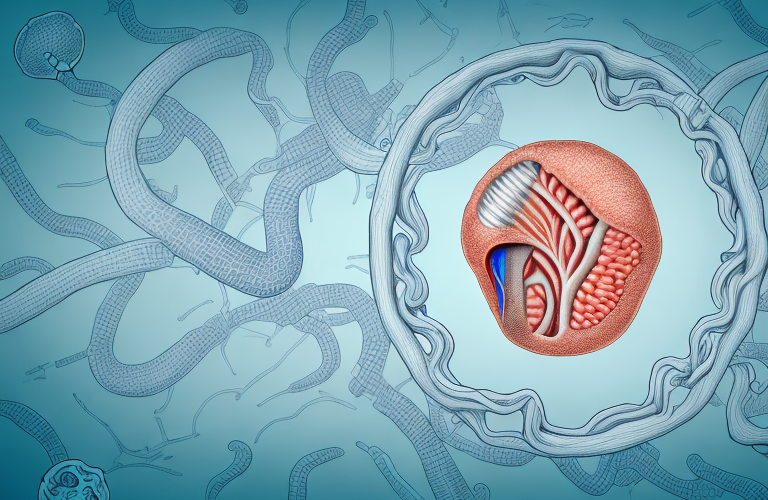Ureteroceles are a rare congenital condition in which the ureter, the tube that connects the kidney to the bladder, swells at the bottom and forms a balloon-like sac. This sac can block the flow of urine from the kidney and cause significant pain and discomfort. In this article, we will explore the causes, symptoms, and treatment options for ureteroceles.
Understanding Ureteroceles: Definition, Types, and Prevalence
A ureterocele is a rare congenital condition that affects the urinary system. It is most commonly seen in infants, but it can occur in adults as well. There are two types of ureteroceles: simple and ectopic. Simple ureteroceles are those in which the sac is located entirely within the bladder, while ectopic ureteroceles are those in which the sac extends outside the bladder. Ureteroceles are more common in females than in males, and they affect approximately 1 in every 4,000 individuals.
Ureteroceles can cause a variety of symptoms, including urinary tract infections, abdominal pain, and difficulty urinating. In severe cases, they can lead to kidney damage or even kidney failure. Treatment for ureteroceles typically involves surgery to remove the sac and repair any damage to the urinary system. However, in some cases, observation and monitoring may be sufficient, especially if the ureterocele is small and not causing any symptoms. It is important for individuals with ureteroceles to receive regular follow-up care to ensure that their condition is properly managed and any potential complications are addressed.
What Causes Ureteroceles? Risk Factors and Contributing Factors
The exact causes of ureteroceles are not yet fully understood. However, researchers believe that both genetic and environmental factors can play a role. Some possible contributing factors include abnormalities in the urinary system, such as malformations of the ureter or bladder, or conditions that affect the nerves that control the bladder. Certain medications or infections during pregnancy may also increase the risk of ureteroceles in infants.
Recent studies have also suggested that there may be a link between ureteroceles and a history of urinary tract infections (UTIs). UTIs can cause inflammation and scarring in the urinary tract, which may lead to the development of ureteroceles. Additionally, individuals with a family history of ureteroceles may be at a higher risk of developing the condition themselves.
Symptoms of Ureteroceles: How to Recognize the Condition
The symptoms of ureteroceles can vary depending on the severity of the condition. In some cases, individuals with ureteroceles may not experience any symptoms, while in others, symptoms can be severe. Symptoms of ureteroceles may include abdominal pain, discomfort during urination, urinary tract infections, and blood in the urine. In infants, symptoms may include failure to thrive, dehydration, and swelling in the kidneys.
It is important to note that ureteroceles can also lead to complications if left untreated. These complications may include kidney damage, urinary tract infections that keep coming back, and even sepsis in severe cases. Therefore, it is crucial to seek medical attention if you suspect you or your child may have ureteroceles.
Diagnosis of ureteroceles typically involves imaging tests such as ultrasounds, CT scans, or MRIs. Treatment options may include surgery to remove the ureterocele or to reconstruct the affected area of the urinary tract. In some cases, medication may also be prescribed to manage symptoms or prevent infections.
Diagnosing Ureteroceles: Tests, Imaging, and Medical History
Diagnosis of ureteroceles typically involves a combination of medical history, physical examination, and imaging tests. Medical history is important, as it can help identify any underlying conditions or risk factors that may be contributing to the development of ureteroceles. Physical examination may reveal tenderness or swelling in the kidney or bladder area. Imaging tests, such as ultrasound, CT scan, or MRI, can provide a detailed view of the urinary system and help confirm the diagnosis of ureteroceles.
In addition to these diagnostic methods, a urine test may also be conducted to check for any signs of infection or abnormalities in the urine. This can help determine if the ureteroceles are causing any urinary tract infections or other complications.
If the diagnosis of ureteroceles is confirmed, further tests may be required to determine the severity of the condition and the best course of treatment. These tests may include urodynamic studies, which measure the function of the bladder and urethra, or cystoscopy, which involves inserting a small camera into the bladder to examine the ureteroceles and surrounding tissues.
Treatment Options for Ureteroceles: Surgery, Medication, and Lifestyle Changes
Treatment options for ureteroceles depend on the severity of the condition and the presence of symptoms. In some cases, ureteroceles may not require immediate treatment, while in others, surgery may be necessary. Medications, such as antibiotics, may be prescribed to treat any infections. Lifestyle changes, such as drinking plenty of fluids, avoiding caffeine and alcohol, and practicing good hygiene, may also help reduce symptoms of ureteroceles.
In addition to these treatment options, some patients may benefit from physical therapy or pelvic floor exercises to help improve bladder control and reduce urinary incontinence. It is important to discuss all treatment options with a healthcare provider to determine the best course of action for each individual case.
Surgical Procedures for Ureteroceles: Endoscopic Surgery vs Open Surgery
If surgery is necessary, there are two main types of surgical procedures that can be used to treat ureteroceles. Endoscopic surgery involves the use of a special tool called an endoscope to view and remove the sac from the ureter. Open surgery involves making an incision in the skin and muscle to access the affected area directly. The choice of surgery will depend on the severity of the condition, the age of the patient, and the preference of the surgeon.
It is important to note that both endoscopic and open surgery have their own advantages and disadvantages. Endoscopic surgery is less invasive and has a shorter recovery time, but it may not be suitable for all cases, especially if the ureterocele is large or complex. Open surgery, on the other hand, allows for better visualization and control during the procedure, but it may result in more pain and scarring.
Complications of Ureteroceles: Risks, Side Effects, and Possible Outcomes
Complications of ureteroceles can include infection, kidney damage, urinary incontinence, and infertility. Risks and side effects of surgery can include bleeding, infection, and pain. The possible outcomes of treatment for ureteroceles depend on the severity of the condition, the age of the patient, and the success of the surgery.
It is important to note that in some cases, ureteroceles can recur after surgery. This can happen if the entire ureterocele was not removed during the initial surgery or if there is an underlying condition that is causing the ureterocele to form. In these cases, additional surgery may be necessary to fully treat the condition and prevent further complications.
Recovery from Ureteroceles Surgery: Postoperative Care and Follow-up Visits
Recovery from ureterocle surgery can take several weeks or months, depending on the type and severity of the surgery. Postoperative care may include pain management, antibiotics, and limiting physical activity. Follow-up visits may be necessary to monitor the healing process and ensure that the condition does not recur.
It is important to follow the postoperative care instructions provided by your healthcare provider to ensure a successful recovery. This may include avoiding certain foods or drinks, such as caffeine or alcohol, that can irritate the bladder and urinary tract. It is also important to stay hydrated and maintain good hygiene to prevent infection. If you experience any unusual symptoms, such as fever, severe pain, or difficulty urinating, contact your healthcare provider immediately.
Preventing Recurrence of Ureteroceles: Lifestyle Changes and Self-care Strategies
Preventing recurrence of ureteroceles may involve making lifestyle changes, such as practicing good hygiene, maintaining a healthy weight, and avoiding smoking. Self-care strategies, such as drinking plenty of fluids and urinating frequently, can also help reduce the risk of ureteroceles recurring.
In addition to lifestyle changes and self-care strategies, medical treatment may also be necessary to prevent recurrence of ureteroceles. This may include regular check-ups with a urologist, taking prescribed medications, and undergoing surgical procedures if necessary. It is important to follow the recommended treatment plan and attend all follow-up appointments to ensure the best possible outcome and reduce the risk of recurrence.
Living with Ureteroceles: Coping Mechanisms and Support Networks
Living with ureteroceles can be challenging, but there are coping mechanisms and support networks available to help individuals manage their condition. Support groups, counseling, and relaxation techniques can all be helpful in managing the physical and emotional aspects of living with ureteroceles.
One coping mechanism that can be particularly helpful for individuals with ureteroceles is maintaining a healthy lifestyle. This includes eating a balanced diet, getting regular exercise, and avoiding smoking and excessive alcohol consumption. These healthy habits can help manage symptoms and improve overall well-being.
It is also important for individuals with ureteroceles to have a strong support system. This can include family, friends, and healthcare professionals who understand the challenges of living with this condition. Support groups specifically for individuals with ureteroceles can also provide a sense of community and understanding.
When to See a Doctor for Ureterocle Symptoms: Urgency and Emergency Cases
If you experience symptoms of ureteroceles, such as abdominal pain, discomfort during urination, or blood in the urine, it is important to seek medical attention right away. In some cases, ureteroceles can be a medical emergency, and prompt treatment can help prevent serious complications.
It is also important to see a doctor if you experience recurrent urinary tract infections, as this can be a sign of an underlying ureterocle. Your doctor may recommend imaging tests, such as an ultrasound or CT scan, to diagnose the condition and determine the best course of treatment.
In some cases, ureteroceles can be present at birth and may not cause symptoms until later in life. If you have a family history of ureteroceles or other urinary tract abnormalities, it is important to discuss this with your doctor and undergo regular check-ups to monitor your urinary health.
Research on Ureterocle Management: Current Studies and Future Directions
There is ongoing research into the management of ureteroceles, including the development of new treatment options and diagnostic methods. Future research may focus on improving early detection and prevention of ureteroceles, as well as exploring the genetic and environmental factors that contribute to the condition.
In conclusion, ureteroceles are a rare but potentially serious condition that can cause significant discomfort and disruption to urinary function. If you suspect you may have ureteroceles or are experiencing symptoms, it is important to seek medical attention as soon as possible to receive an accurate diagnosis and appropriate treatment.
One promising area of research is the use of minimally invasive surgical techniques for the treatment of ureteroceles. These techniques, such as laparoscopic and robotic surgery, can offer patients faster recovery times and fewer complications compared to traditional open surgery. However, more studies are needed to determine the long-term effectiveness of these procedures and their potential risks.










